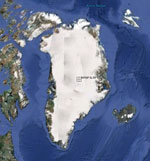
Apparently the American Geophysical Union’s readiness to speak out on climate change which I reported in a recent post was not as the LA Times portrayed it. Joseph Romm has written of his disappointment that the AGU is constrained by a determination to veer away from anything that could be construed as advocacy. They state that the email exchange forum they have set up for journalists is designed to answer questions about the current state of scientific knowledge, with a special emphasis on the physical sciences that relate to climate change. Non-science questions such as those relating to policy, ethics, or economics will be returned to sender for refinement.
One example they provide is the question, “Is current U.S. infrastructure adequate for sea level rise?” Such a question will be returned to sender on the grounds that judgments of adequacy involve tradeoffs in risk and in policy. The scientists will only answer the question if it is changed to “What amount of sea level rise might occur this century?”
It’s a stark contrast with climatologist James Hansen, who recently delivered an open lecture in Japan on the occasion of his being awarded the prestigious Blue Planet Prize. The text and powerpoint charts can be accessed on his website. He doesn’t hold back. Here are the opening words:
“Human-made climate change is a moral issue. It pits the rich and the powerful against the young and the unborn, against the defenseless and against nature.
“Climate change is a political issue. But politics fails when there is a revolving door between government and the fossil fuel-industrial complex.
“Climate change is a legal issue. The judiciary provides the possibility of holding our governments accountable for their duty to protect the public interest.”
The accompanying slide has a footnote that statements relating to policy are personal opinion.
Of course Hansen then proceeds with the science of climate change, explaining the current position with his usual clarity.
“It is difficult for the public to recognize that we have a crisis, because human-made global warming, so far, is small compared to day-to-day weather fluctuations. Yet the fact is: we have an emergency. Because of the great inertia of the ocean, which is four kilometers deep, and the ice sheets, which are two to three kilometers thick, the climate system responds slowly to climate forcings such as increasing greenhouse gases. But this inertia is not our friend, because it increases the danger that we may pass tipping points, beyond which the dynamics of the climate system takes over and rapid changes occur out of humanity’s control.”
He offers three examples of tipping points. The ice sheets of Greenland and Antarctica, especially the West Antarctic ice sheet, are one. If an ice sheet is weakened to the point that it begins to collapse then the dynamics of the process take over. Another non-linear problem is the extermination of species which can accelerate because of the interdependencies among species. A third is methane hydrates, essentially frozen methane. If they begin to disintegrate the process could become self-sustaining. He notes these tipping points have all occurred during Earth’s history in conjunction with warming climates.
At this point in his lecture he again crosses into the kind of territory that the AGU eschews for its scientists.
“Climate inertia and tipping points give rise to potential intergenerational injustice. Today’s adults enjoy the benefits of fossil fuel use, but the impacts will be borne by young people and future generations. Our parents did not know that their actions would affect future generations. We do not have that excuse. We can only feign ignorance. It is called denial.”
There was a lengthy period following Hansen’s testifying to Congress in the 1980s during which he decided to concentrate on research and leave public communication to others. He tells how it was the arrival of his grandchildren combined with the growing gap between what was understood of the science and what was known by the public that brought him back to public communication. In 2004 he gave a carefully prepared public talk titled “Dangerous anthropogenic interference: a discussion of humanity’s Faustian climate bargain and the payments coming due”.
His public lecture in Japan is the latest example of his readiness to couple the communication of the science with clear assessment of the risk and with concrete recommendations as to how that risk may yet be avoided. As his lecture proceeds he explains the basis of our current scientific understanding. It depends most of all on Earth’s paleoclimate history, then on ongoing global observations showing how climate is responding to rapid changes of atmospheric composition, and finally on climate models and theory which are helpful in interpreting what is happening and needed to predict future changes. There’s a pile of interesting material which follows which I won’t try to summarise here, save to say that he points out that the human-caused rise in atmospheric carbon dioxide is occurring at a rate 10,000 times faster than the natural geologic change of the Cenozoic era of the past 65 million years. He also explains his assessment that a level of no more than 350ppm of atmospheric carbon dioxide is required if we wish to preserve the planet on which civilisation developed.
He’s not backward in spelling out policy implications. We must halt all coal emissions in 20 years, not develop tar sands, oil shale or methane hydrates, and not pursue the last drops of oil in polar regions, deep sea drilling or pristine land. “In other words, we must move on to the clean energy future now, rather than using all the remaining fossil fuels.”
There’s as yet no sign of our doing so:
“But what is really happening? The United States has signed an agreement with Canada for a pipeline to carry tar sands oil to Texas. New coal plants are being built all around the world, some being financed by the World Bank. Environmentally destructive mountaintop removal continues. Oil is pursued in pristine places. The environmentally destructive practice of shale fracturing is being developed and implemented to find the last bits of gas.
“There is a huge gap between government rhetoric and policy reality. Leaders say that we have a ‘planet in peril’, yet their proposed policies barely differ from business-as-usual. Greenwash is plentiful, but the leaders follow a path of appeasement of fossil fuel special interests. There is no Winston Churchill willing to stand up and tell the truth about what is needed.”
Hansen then moves to his policy prescriptions which include a rising price on carbon, government regulation, and technology development driven by the certainty of the carbon price. He is not diffident in offering them, but his audience would have no difficulty recognising when he has moved from presentation of the science to advocacy of a particular response.
The notion that a scientist’s responsibility ends where a politician’s begins is simplistic. Politicians often enough show little sign of fully appreciating the reality of the science, and even if they do they appear to have an endless capacity to shy away from appropriate action. Are scientists like Hansen supposed to stay in their sanctums and be satisfied with issuing bulletins on the state of the science? And when they see the mayhem created by industry denial and media confusion and political timidity are they supposed to just shrug their shoulders and get on with their research? Even though they know what that research indicates for the human future if we carry on as usual?
Hansen’s record makes it quite clear that advocacy doesn’t mean compromising research. His scientific work continues and wins respect in its own right. Joe Romm has reason to be disappointed that the AGU has put such stringent limits on its scientists’ communication with journalists.
[REM]
Like this:
Like Loading...
 Over the holiday period I’ve had a number of people point me at the latest “essay” by Don “Cooling-gate” Easterbrook — it was featured in full at µWatts, translated into German and Dutch, and made headline material for Morano: Geologist: 9,099 Of Last 10,500 Years Warmer Than 2010. I was a little surprised. I thought that recent temperatures were the warmest for at least hundreds, and probably thousands of years. But this is Easterbrook, and he’s up to his old tricks. He’s “hiding the incline” in temperatures by mangling the data from Greenland ice cores. Has he learned nothing since I last looked at his “work”? Apparently not.
Over the holiday period I’ve had a number of people point me at the latest “essay” by Don “Cooling-gate” Easterbrook — it was featured in full at µWatts, translated into German and Dutch, and made headline material for Morano: Geologist: 9,099 Of Last 10,500 Years Warmer Than 2010. I was a little surprised. I thought that recent temperatures were the warmest for at least hundreds, and probably thousands of years. But this is Easterbrook, and he’s up to his old tricks. He’s “hiding the incline” in temperatures by mangling the data from Greenland ice cores. Has he learned nothing since I last looked at his “work”? Apparently not.


